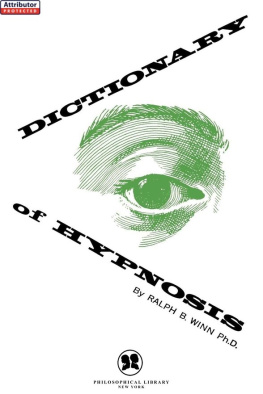Anthony Jacquin - Reality is Plastic: The Art of Impromptu Hypnosis
Here you can read online Anthony Jacquin - Reality is Plastic: The Art of Impromptu Hypnosis full text of the book (entire story) in english for free. Download pdf and epub, get meaning, cover and reviews about this ebook. year: 2016, publisher: Anthony Jacquin, genre: Religion. Description of the work, (preface) as well as reviews are available. Best literature library LitArk.com created for fans of good reading and offers a wide selection of genres:
Romance novel
Science fiction
Adventure
Detective
Science
History
Home and family
Prose
Art
Politics
Computer
Non-fiction
Religion
Business
Children
Humor
Choose a favorite category and find really read worthwhile books. Enjoy immersion in the world of imagination, feel the emotions of the characters or learn something new for yourself, make an fascinating discovery.
- Book:Reality is Plastic: The Art of Impromptu Hypnosis
- Author:
- Publisher:Anthony Jacquin
- Genre:
- Year:2016
- Rating:3 / 5
- Favourites:Add to favourites
- Your mark:
- 60
- 1
- 2
- 3
- 4
- 5
Reality is Plastic: The Art of Impromptu Hypnosis: summary, description and annotation
We offer to read an annotation, description, summary or preface (depends on what the author of the book "Reality is Plastic: The Art of Impromptu Hypnosis" wrote himself). If you haven't found the necessary information about the book — write in the comments, we will try to find it.
Reality is Plastic: The Art of Impromptu Hypnosis — read online for free the complete book (whole text) full work
Below is the text of the book, divided by pages. System saving the place of the last page read, allows you to conveniently read the book "Reality is Plastic: The Art of Impromptu Hypnosis" online for free, without having to search again every time where you left off. Put a bookmark, and you can go to the page where you finished reading at any time.
Font size:
Interval:
Bookmark:

This work is owned and published by Anthony Jacquin.
Reality is Plastic: The Art of Impromptu Hypnosis.
First published 2007. Reprinted with revisions 2008 and 2015.
Published digitally 2016.
The right of Anthony Jacquin to be identified as the author of this work
has been asserted by him in accordance with the UK Copyright,
Designs and Patents Act 1988.
Anthony Jacquin 2016
All rights reserved worldwide.
No part of this publication may be stored in a retrieval system, transmitted or reproduced in any way, including but not limited to digital copying
and printing, without the prior agreement and written permission of the author.
You must not use this product for commercial use, except for the purposes of your own professional development, by which we mean that:
You may use this product as a reference for your own hypnosis sessions in accordance with acceptable practices, permissions and ethics; but
You may not claim to be associated with Anthony Jacquin in any way or use his name in connection with your own practice unless given permission
by the author to do so.
Photography by Red Square Photography Studio and Vivid Creative Ideas.
Graphic design by Overthrow Productions Ltd.
Proofread by Barry Cooper and Jennifer Jones.
Edited by Jesse Cummins.
Formatted by Dean Groombridge
Anthony Jacquin
Room 6-8 St. James St. Derby, Derbyshire, DE11RF, United Kingdom
Email: enquiries@anthonyjacquin.com
Web: www.anthonyjacquin.com
ISBN: 978-0-9559084-1-5


Code of Conduct
Remain disciplined
Conduct yourself ethically as a hypnotist
Practise courtesy and respect
Serve your audience and respect your subject
Love your fellow students
Be united and avoid conflicts
Train diligently
Maintain your skills
Develop tranquillity
Abstain from arguments and fights
Participate in society
Be moderate and gentle in your manners
Help the weak and young
Use hypnosis for the good of humanity
Pass on the tradition
Preserve this hypnotic art and its rules of conduct

The 17 Musts
Right attitude
Right intention
Right effort
Right action
Be firm with instructions
Be clear with suggestions
Be meaningful when communicating ideas
Be artfully vague only when necessary
Be accurate with timing
Be the master of personal space
Be alert with your eyes
Coordinate your words and actions
Unite your actions and intentions
Thinking must be agile
Reaction must be swift
Comprehend the principles of push and pull
Be still
Be grounded
Walk don't run
Pace and lead
Be steady with your breathing and strength
Be commanding with your demeanour
Test your work
Be sure to end clean

About Reality is Plastic:
The Art of Impromptu Hypnosis
This book is a resource for those professing to be or wishing to become hypnotists. It is not a substitute for hands-on training from a professional hypnotist who is accomplished at delivering training. However, if you follow the guidelines in this book and have the right attitude and aptitude, as well as enough front, talent and confidence, you will hypnotise people.
With this ability comes responsibility. Hypnosis can be used for fun, to create laughter and to provoke wonderful therapeutic changes in people. It can just as easily result in confusion, fear and unhelpful changes. If you know what you are doing, then the chances of causing even temporary distress or upset are extremely small.
With this in mind, this book closes with information about how to use hypnosis in a way that ensures the well-being of all concerned. Read that chapter. Use your common sense with regard to health and safety, and decent morals and ethics with regard to your application of hypnosis.
Throughout this book and my other training products and courses, I offer suggestions for words, phrases and in some cases complete scripts that will be useful to you; however, my emphasis when training people is that to be a good hypnotist, you must first become The Hypnotist and think of yourself as The Hypnotist. Your attitude, persona and confidence carry more weight than any script or linguistic trick. Where I have offered suggestions for what to say, please understand that these are the words I use; they work for me. I have belief in them. In some cases they may seem very brief, but I can assure you nothing has been left out, nothing superfluous added.
When hypnotising I use these words and techniques over and over without a huge amount of variation, just some personalisation depending on whom I am addressing. In that sense they have become my patter or script. Do not feel you must repeat them verbatimalthough that is not a bad place to start if you are a complete beginner. Use them as a starting point. The words you use to do your work as The Hypnotist must sound right to you. They must be easily understood and resonate with those you address. You are going to use them to focus the attention of your subject and suggest ideas to them. Take these scripts and branch off from them. Develop your own style of patter and you will be more effective. Scripts are not spells and should not be read. It is not the words that do the hypnotising; you do. Even if you use exactly the same words that I do, ensure that you take ownership of them; rehearse over and over until they become part of you.
A number of conventions have been used to make any scripted portions of the book easier to understand:
Throughout we will refer to the Hypnotist as The Hypnotist.
We will refer to the person being hypnotised as the subject. Any words intended to be spoken to the subject are in bold.
General text and any descriptive instructions are written in this plain text. These instructions should not be spoken to the subject.
In hypnosis you are primarily going to use words to influence your subject, so you should know what you are saying. Aim to become a master of communication. Reflect upon the words you use and their many meanings and associations. You should pay attention to how you deliver suggestions and how best to instruct your subject. Learn to use your vocal tone and tempo to communicate your intention clearly and understand when to use silence and emphasis.
All of this will improve your communication skills and help you become an excellent hypnotist. You will swiftly begin to develop your own favoured suggestions and style.
There is nothing wrong with imitating. It is one way of learning. Watch shows and clips of the best hypnotists at work. Read around the subject too. The best hypnotists appear totally confident, expecting nothing less than complete success. They appear knowledgeable and totally certain about what they are doing. Ultimately be yourselfjust more so.
Contents

Font size:
Interval:
Bookmark:
Similar books «Reality is Plastic: The Art of Impromptu Hypnosis»
Look at similar books to Reality is Plastic: The Art of Impromptu Hypnosis. We have selected literature similar in name and meaning in the hope of providing readers with more options to find new, interesting, not yet read works.
Discussion, reviews of the book Reality is Plastic: The Art of Impromptu Hypnosis and just readers' own opinions. Leave your comments, write what you think about the work, its meaning or the main characters. Specify what exactly you liked and what you didn't like, and why you think so.









